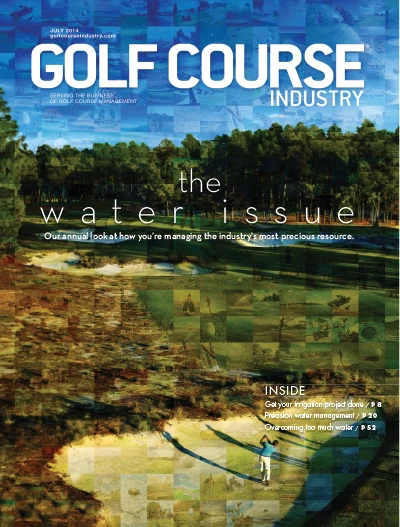 Henry DeLozier |
According to the U.S. Geological Survey, 71 percent of the earth’s surface is covered with water. Most of it – 96.5 percent, in fact – is in our oceans. The rest of it – about 3.5 percent of the world’s water – is in icecaps, glaciers, rivers, streams, lakes and in the form of water vapor. It’s that 3.5 percent that we’re lusting over, fighting for and paying increasingly larger amounts of money to access. Ironically, many water users – clubs and courses included – are unaware of the value of water. For a resource that is in such short supply in many areas, the fair-market value of water is a sometimes overlooked and undervalued asset. The due diligence that is dedicated to water for golf course transactions is often inadequate to the value of the asset, according to some water experts. “The most common mistake is taking water supply for granted. Some golf course managers assume that water will always be available and cost-competitive, similar to other utility services, like power,” says Boise-based WaterExchange Managing Director Clay Landry. This is an outmoded way of thinking, Landry warns. “Ignoring water supply issues can lead golf course managers to assume unknown risks, overlook profitable water marketing opportunities and pay too much for water.” Landry says WaterExchange has seen golf course transactions in recent months in which water supplies received only cursory research during the due diligence phase. “More attention to water risks is warranted, particularly in states like California and Texas where drought is threatening golf course water supply reliability,” he says. At Water Research in Phoenix, Senior Associate Matt Payne recommends that golf’s water users view water as an asset to be managed for maximum value. “Water rights and their market value are poorly understood. In most markets, water rights are thinly traded and few comparable sales are available for valuation. In addition, many water rights have distinctive features that complicate valuation,” Payne says. Payne adds that proactively valuing water rights and investigating their marketability will go a long way toward optimizing asset management from water supply and financial standpoints. What’s more, understanding water-related risks and evaluating those risks against overall property value is the best guidance for golf course users. For course owners and managers, the USGA is an excellent resource, providing guidance and best practices concerning water use through its various publications and educational programs. Eighteen regional agronomists lend their expertise regarding turfgrass. “The USGA has sponsored turfgrass research since the 1920s. When you look through the archives, you can connect much of this 90-plus years of research to developing grasses that use less water for (golf course) maintenance,” says Kimberly Erusha, the managing director of the USGA Green Section. In the late 1980s, the USGA Turfgrass and Environmental Research Program set a goal to develop grasses that required half the amount of water that most turfgrass at the time needed. Buffalo grass, which uses less than one inch of water per month; seashore paspalum, which can tolerate high salt water for irrigation; and more cold-tolerant Bermuda grasses have since been developed with the USGA’s support. In addition, cultivars have been developed that better tolerate environmental stresses. The USGA’s Erusha points out several opportunities for courses to conserve water:
Everyone it seems is talking about this limited resource. The smartest golf course owners, managers and superintendents are actually doing something about it.
Henry DeLozier is a principal in the Global Golf Advisors consultancy. DeLozier joined Global Golf Advisors in 2008 after nine years as the vice president of golf for Pulte Homes. He is a past president of the National Golf Course Owners Association’s board of directors and serves on the PGA of America’s Employers Advisory Council. |
Get curated news on YOUR industry.
Enter your email to receive our newsletters.
Explore the July 2014 Issue
Check out more from this issue and find your next story to read.
Latest from Golf Course Industry
- PBI-Gordon Company hires marketing manager Jared Hoyle
- Mountain Sky Guest Ranch announces bunker enhancement project
- GCSAA names Joshua Tapp director of environmental programs
- AQUA-AID Solutions bolsters Sunshine State presence
- Escalante Golf acquires secluded Illinois course
- Tartan Talks 105: Nathan Crace and Todd Quitno
- Disease Discussion 24: Let the turf talk to you
- From the publisher’s pen: Foggy intrigue





